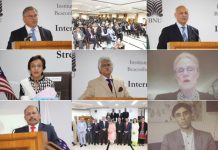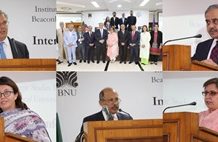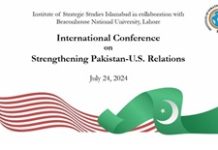China has been drawing the world’s attention. It has now turned into the land of emerging opportunities. China could influence and alter outside strategies, policies, and opinions and the world would re-shape economically and strategically. The 21-member annual summit of the Asia-Pacific Economic Cooperation (APEC), held at Beijing on 5-11th November, provides a wider interaction across the Asia-Pacific leaders to re-shape trade and economies. The summit will be attended, amongst others, by Barack Obama, Vladimir Putin, Shizo Abe, Xi Jinping, and Tony Abbott.
The forum was set up in 1989. It is a unique forum. It brings leaders across Asia and the Pacific closer. Trade is their main concern. The Beijing summit is drawing global attention; global trade, financial structures, and security would draw the attention of leaders at the APEC summit. Sideline meetings provide room to decrease mutual tensions.
The fight against global corruption was taken seriously at the summit. It was a Chinese proposal backed by other APEC members. China has been cracking down on corruption at all levels and trying to extradite corrupt people taken safe refuge abroad. China arrested over 13,000 corrupt officials including many powerful among them. APEC would share information about corruption and it will set up a network to track it down.
China and 20 Asian countries set up an Asian Investment and Infrastructure Ban (AIIB) on 24 October in Beijing. The West has its own reservations about the bank. Asian finances and needs have increased manifold and there was a need to have another bank after the Asian Development Bank (ADB).
Sidelines meetings resolve many contentious issues between leaders. China and Japan are on the divergent path especially after the Senkaku / Diaoyu renewed spade in 201o. Japan nationalized the Islands in 2012, thus further damaging ties between the two neighbors. The Yasukuni Shrine visit by Abe has been strongly opposed by China. Abenomics needs closer economic cooperation with China, which Japan can afford to ignore. Abe took more anti-China stances since he came into power in 2012. Going to China by a Japanese leader, matters a lot under these given scenarios.
The rhetoric may come down at the APEC summit. Former Japanese Prime Minister Yasuo Fukuda went to China in summer on track-two diplomacy. Abe might recognize that the Island is a dispute issue with China. In that case China may shelve the issue for some time until relations improve between the two nations. Both countries need to work on this new doctrine by shelving differences and moving ahead.
China and Japan have huge differences and are moving in their own ways without bridging differences. Asian century is much divided between them. A common stand is still far away. They have differences over the Trans-Pacific Partnership (TPP). China proposes the Free Trade Agreement for Asia-Pacific (FTAAP). There is a Regional Comprehensive Economic Partnership (RCEP) too. APEC, TPP, FTAAP, and RCEP all promise to restructure trade in Asia-Pacific on free basis but politics drives them differently. Global strategic issues affect them separately.
Militarily, Japan has becoming more assertive by introducing changes in its constitution. The Korean Peninsula adds more frustration. Asian leaders mince their own words. The sideline meeting may create room for Xi and Abe to interact with each other as well as between other leaders. They would hold a separate meeting.
Hong Kong pro-democracy movement and China’s strained ties with Taiwan are matters of concerns. Protestors want to push for their voice when the APEC leaders gather in Beijing. China has been improving ties with Vietnam disturbed by anti-Chinese riots.
Pakistan is not an APEC member. Pakistan is a part of the Host-Partners Dialogue and it has its own agenda, which is more concern with China. As Chinese President Xi Jinping could not visit Pakistan in September because of the volatile situation in Islamabad, APEC Host-Partner Dialogue provided an opportunity to Prime Minister Nawaz Sharif on 7-9 November to meet with Chinese leadership and to discuss and ink 19 agreements worth US$ 42 billion under the China-Pakistan Economic Corridor. Most of the agreements are in the power sector and in infrastructure development. Under power agreements, 16,520 mw electricity will be generated. These agreements are not loans or aid but pure investment offered by China. This is the highest amount of Chinese investment ever signed with any country. The Government is lucky to have fetched Chinese investment within 55 days after it was delayed in September.
Pakistan was more concerned about these agreements than the deliberations of the APEC summit. Pakistan also became the founding member of the AIIB. The country has an observer status in the Shanghai Cooperation Organization (SCO). To fight terrorism, both countries adopted a common strategy. Both countries increased their coordination towards Afghanistan and to fight against the East Turkistan Islamic Movement (ETIM) China invested US$ 700 million in FDI in Pakistan during 2013-14 and emerged as the largest investor. Trade has been expanding under the Free Trade Agreement (FTA) signed in 2007 and reached US$15 billion. Now China has emerged as Pakistan’s largest trading partner along with a second exports destination after the United States.
Pakistan’s economy has been showing signs of recovery and improvement. This has further attracted China towards Pakistan. In nuclear, hydro, coal, and solar power sector China has been assisting Pakistan. Traditionally, partners in defense and strategic infrastructure, both countries have been moving ahead in expanding trade and investment relations.
Views expressed are of the author and do not necessarily reflect the views of ISS or of the Government of Pakistan













